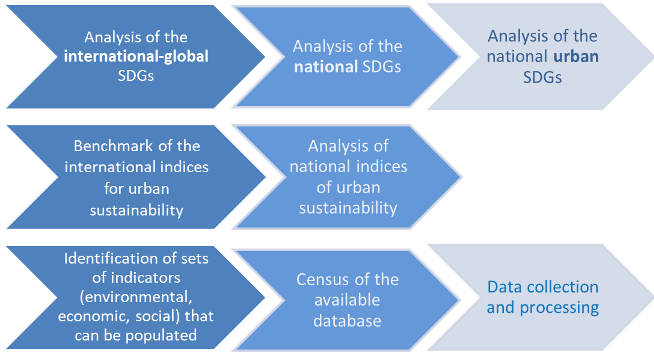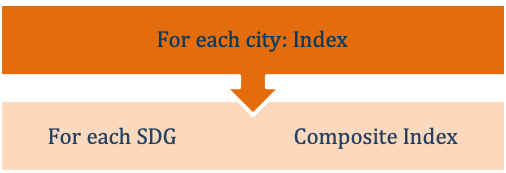Fondazione Eni Enrico Mattei together with the Italian Network for Sustainable Development (SDSN Italia) developed the project “SDSN Italia SDGs City Index”.
The Italian Report takes as reference unity the municipality– political and administrative entity primarily responsible for a wider range of policies supposed to influence the territory under jurisdiction. It includes indicators for 16 out of 17 SDGs, with the exclusion of Goal 14 (Life Below Water) due to comparability reasons.
One of the aims is to bridge the existing gap in the national context, a) making a link between the Italian reality as a whole and the local sphere, and b) considering the economic, social, geographical and demographic heterogeneity of our country.
The City Index also serves as an analytical planning tool for cities to encourage reflection on policies that can address current global challenges, while at the same time helping raise awareness of public bodies, stakeholders and civil society on the achievement of the international Sustainable Development Goals (SDGs). Therefore, the shared project develops a tool that photographs the "implementation status" of SDGs in the main Italian cities and metropolitan areas; this is to help local communities tackle the still unresolved issues affecting single cities.
Thanks to the Report, local administrators can take inspirations from the 2030 Agenda to face, in a coordinated manner, the main challenges of our cities – from fighting poverty to assuring energy efficiency, from sustainable mobility to social inclusion. Also, by virtue of the Index, decision makers can identify other territorial realities with similar situations and challenges, thus facilitating the national dialogue in order to promote and accelerate progress.
The project that led to the birth of the City Index started in 2018; after six months its results were published in the Report “Per un’Italia Sostenibile: l’SDSN Italia SDGs City Index”.
A first set of indicators and data has recently been upgraded (February 2020): they will be resulting in a new Report planned in late Autumn 2020.
Considered that the Italian City Index will be updated every two years, old indicators are going to be continuously updated and new ones added, making possible a comparison over different years.
The first Report (FEEM, 2018) analyses 101 Italian municipalities depending on 39 indicators over 16 out of 17 Sustainable Development Goals, as defined by the United Nations in 2015. The upgrade of the same includes 48 indicators on the same Goals.
The analysis behind is part of the wider international framework as defined by the Sustainable Development Solutions Network (SDSN) for the identification of statistical indicators capable of measuring cities’ performance with respect to the SDGs. The project took its first steps from the international 2030 Agenda, intersected with the Italian National Strategy for Sustainable Development and the Urban Strategy for Sustainable Development.


Step 1: Recognition of the municipality indicators (international and national level)
As a starting point, international and national sources applying different methodologies for the evaluation of urban policies have been examined, with both being based on urban indicators and with any link with the Sustainable Development Goals. For their special relevance, it is necessary to mention the following documents:
- Global indicator framework for the SDGs and targets of the 2030 Agenda for Sustainable Development;
- SDG UN indicators for Sustainable Development;
- SDG Index and Dashboards Report 2017. Global Responsibilities - International Spillovers in Achieving the Goals;
- ISO 37120. Sustainable development of communities – Indicators for city services and quality of life;
- The U.S. Cities Sustainable Development Goals Index 2017, Achieving a Sustainable Urban America;
- CASBEE for CITIES 2015. Environmental Performance Assessment Tool for Municipalities;
- ICity Rate. La classifica delle città intelligenti italiane 2017 e 2018;
- Sustainable development in the EU. Monitoring report on progress towards the SDGs in an EU context.
Most of the indicators defined by these methodologies are not of a direct application to the municipal context; for this reason, an adaptation process followed.
Step 2: Identification of a set of elementary indicators (environmental, economic and social ones), data collection and elaboration of the information
In order to identify suitable SDG indicators, potential indicators have been collected, evaluated and selected. The evaluation refers to individual criteria such as e.g. validity, availability and quality of the data. A first filter has consisted in the identification of those indicators being more relevant for urban ecosystems from a sustainability point of view. The latter have been gathered based on key words-target for each SDG.
Step 3: Collection of the elementary indicators
The selected SDG indicators have been collected from central sources (e. g. national statistical offices, national employment agencies, national research centres, national ministries). The data have been gathered, if possible, from all municipalities-capitals of provinces of our country.
A final list of quantitative indicators has been drafted and associated to the appropriate target. Qualitative indicators have been discarded, as well as those resulting from surveys and those whose outcome was binary (for example, presence or absence of services such as bike sharing).
At the same time, databases have been filtered, considering as valid the only values referring to municipal or provincial scale, depending on the context of evaluation. According to reliability criteria, only local and/or scientifically recognized sources providing public and consolidated data have been consulted as valid.
As far as possible, priority has been given to set of international data sticking to the repeatability criterion. In the case where these official indicators were not available at urban scale, alternative indicators with the same purpose were selected.
Step 4: Normalization and aggregation
Those indicators resulting more appropriate for the representation have been selected and normalized in order to guarantee the same unit of measurement; finally, data have been aggregated by SDGs through a specific function.
Step 5: Presentation of the results
The results have been presented without aggregations, neither territorial, nor by macro-area (economic, social, political or environmental). The methodical approach and the project results are described in detail in a publication. Furthermore, individual contents of the publication (indicator catalogue, indicator fact sheets etc.) are provided online, as Word or Excel documents (Report available here: https://www.feem.it/m/projects/2018-cavallifarnia-sdsnitaliasdgscityindex2018.pdf; individual contents available here: https://www.feem.it/it/ricerca/programmi/firms-and-cities-towards-sustainability/ongoing-projects/indice-di-sviluppo-urbano-sostenibile-per-l-italia-ii-sdg-/ongoing-projects/).
The main results and outputs consist of achieving a shared measure of the degree of achievement of the SDGs at the urban level; establishing a database of indicators for urban monitoring of SDGs, as well as identifying relevant information gaps; selecting the priorities for action for (in) each city; stimulating the debate on the role of cities and on city action on SDGs.